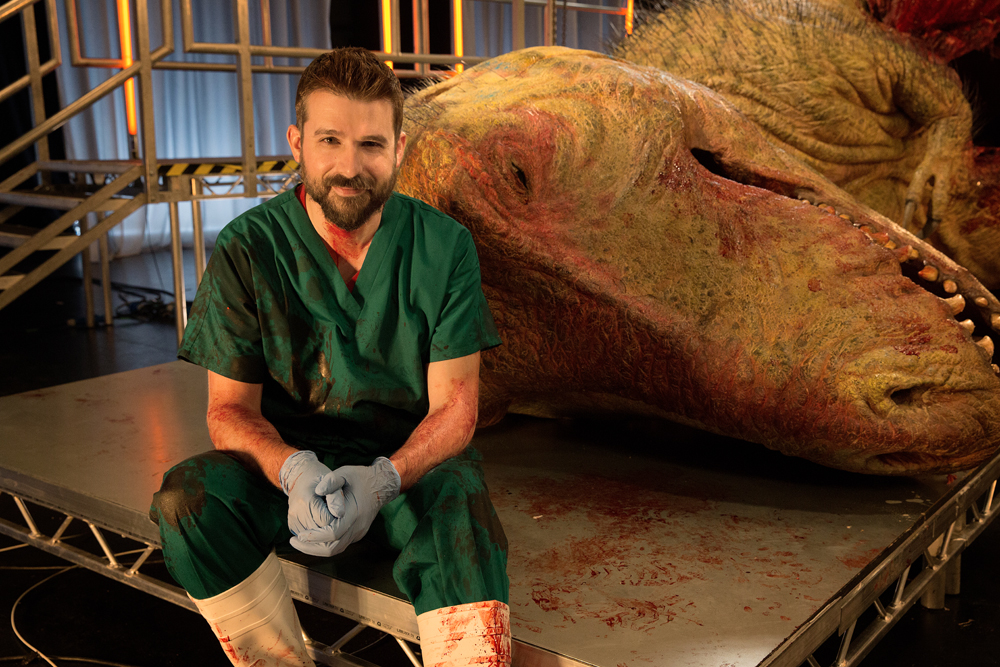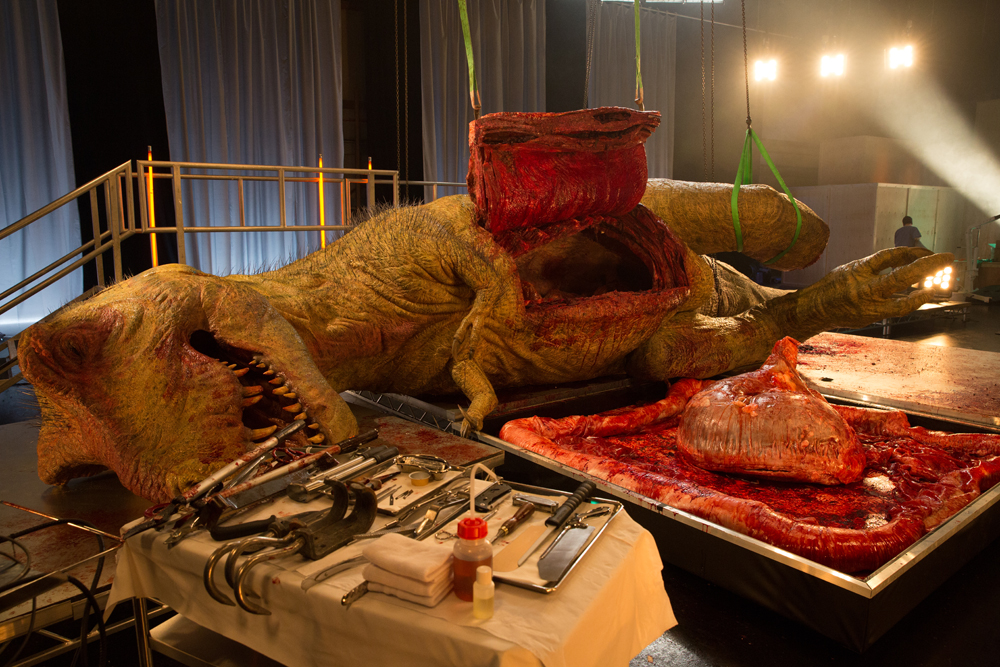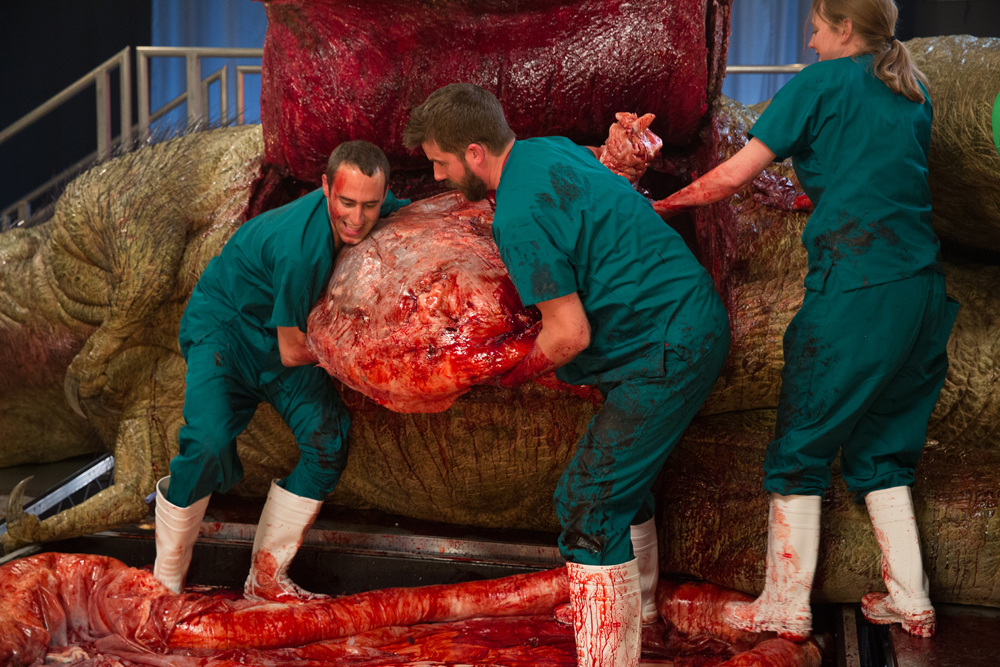Meet the Guy Who Fake-Dissected a T. Rex

All kids dream of owning their own pet dinosaur. But dissecting one?
Dream or not, the National Geographic Channel is set to make dinosaur dissection a reality — or at least as close to reality as possible. With the help of a special-effects shop and gallons of dyed corn-syrup "blood," three paleontologists and a veterinary surgeon got the chance to go inside a life-size, anatomically realistic Tyrannosaurus rex for a new TV special airing Sunday, June 7 at 9 p.m. EDT/8 p.m. CDT).
Live Science talked to Matthew Mossbrucker, one of the stars of the special, called "T. rex Autopsy." Mossbrucker, director and curator of the Morrison Natural History Museum in Colorado, explained via email the allure of slicing up a fake T. rex for television.
Live Science: So. Dissecting a life-sized T. rex model: Why? Just … why?
Mossbrucker: Why not?
This is a new species of dinosaur documentary. Come for the gore; stay for the science. Sure, there's a campy bit of "Saw" meets "Jurassic Park" with a dollop of "Sharknado," but there is genuine science behind the special. Through "T. rex Autopsy," we communicate the latest research and findings about T. rex to the viewers at home. [See 'Gory' Photos of the T. Rex Autopsy]
Personally, I love the idea of taking an animal that is thought of as a fearsome, bloodthirsty killer and exposing the real animal beneath the pop-culture lore. Dinosaurs are not monsters; they're animals with the same frailties and general experiences of today's critters. Through "T. rex Autopsy," we can explore organ systems that all bony critters — including us — share. We even touch on dinosaur genitalia and reproduction.
Sign up for the Live Science daily newsletter now
Get the world’s most fascinating discoveries delivered straight to your inbox.
You're welcome.
LS: What was this faux T. rex made out of?
Mossbrucker: Latex and love. The team at Crawley Creatures — the visual-effects wizards that built the dissectible model — based it on the very latest research and actual fossils. It was constructed using 113 pieces of fiberglass, wood, steel, latex, silicone, foam and gallons of stage blood. The dinosaur took 10,000 artist hours and five and a half months to build — and over 30 hours to completely cut apart.

LS: No offense to your slice-and-dice role in this, but it seems like it would take more science to make a realistic T. rex than to cut one up. How much science went into making this model? Did you find it realistic?
Mossbrucker: Offense taken! You've besmirched our fine model!
While there is always room for improvement, it turns out that we know Tyrannosaurus rex fairly well. The fossils themselves provide a wealth of data, from diet to movement and more. The context of the rock we find them [the fossils] in places "Rex" in the "when" and "where" — the ecosystem it was a part of so long ago. The comparative anatomy of modern animals gives us insight into the parts of this animal that aren't yet known. We can dissect and compare T. rex cousins like chickens and alligators to give us insight. For an animal never seen alive by humans, we know an awful lot about the Tyrant King.
I may have tweaked the beast here and there, but it was a solid effort. Frankly, if you were to get five dino-geeks in the same room and ask them to create their vision of a T. rex, you'd get 23 different interpretations. The T. rex model from "Autopsy" is conservative and defensible.

LS: You don't get to study dinosaur innards in real life, but bones can be surprisingly informative. What is the coolest thing we can learn from fossilized skeletons?
Skeletons are a glorious (and sometimes subtle) record of an animal's physical appearance, ecological niche and evolutionary heritage. A fossil skeleton of an extinct animal is a gateway to deepening our understanding of how life on this planet has adapted and survived time and again. Extinction knocks it down, but life comes back. As the illustrious Dr. Ian Malcolm [from "Jurassic Park"] says, "Because life, uh, finds a way."
LS: T. rex gets all the attention. What lesser-known dinosaur do you want to fake-dissect next?
Follow Stephanie Pappas on Twitter and Google+. Follow us @livescience, Facebook & Google+. Original article on Live Science.

Stephanie Pappas is a contributing writer for Live Science, covering topics ranging from geoscience to archaeology to the human brain and behavior. She was previously a senior writer for Live Science but is now a freelancer based in Denver, Colorado, and regularly contributes to Scientific American and The Monitor, the monthly magazine of the American Psychological Association. Stephanie received a bachelor's degree in psychology from the University of South Carolina and a graduate certificate in science communication from the University of California, Santa Cruz.










